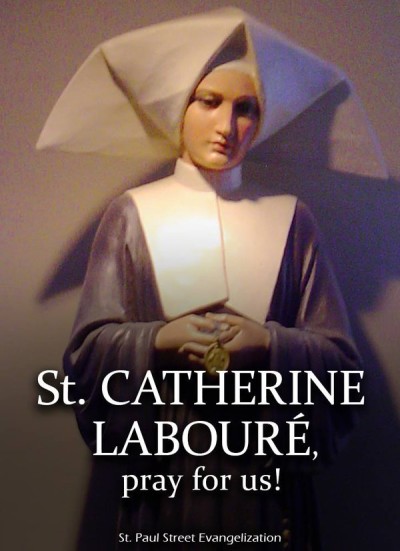 St. Catherine Laboure (1806-1876)
St. Catherine Laboure (1806-1876)
Image: St. Paul Street Evangelization
(CNA) Born in France Burgundy and given the birth name Zoe, she was of a large family and the 9th of 11 children, her mother passed when Zoe was just 8 yrs old according to SQPN and her older sister joined the ‘Sisters of Charity’ which necessitated Zoe to assume the daily household duties, it was said of her, that she was a very quiet and practical child, subsequently Zoe worked as a waitress in Paris at her Uncle’s cafe.
As a young Woman of 24, Zoe became a member of the nursing order founded by St. Vincent de Paul (Feast Day: 27 September) according to Laboure Society — Zoe was very devout, of a somewhat romantic nature, given to visions and insights, she chose the Daughters of Charity after receiving a vision in which St. Vincent told her that God wanted her to work with the sick and upon joining the Order, took the name Catherine.
On the night of the 18 July, 1830 Catherine awoke from sleep after hearing the voice of a child calling her to the Chapel and subsequently heard the Virgin Mary say to her, “God wishes to charge you with a mission. You will be contradicted but do not fear, you will have the grace to do what is necessary. Tell your spiritual director all that passes within you. Times are evil in France and the world.”
On the 27 November, 1830 the Blessed Mother returned to Catherine during evening meditations, displaying herself in an oval frame, standing upon a globe, wearing many rings of different colors, most of which shone rays of light over the globe, around the margin of the fame appeared the words: “O Mary, conceived without sin, pray for us who have recourse to thee.” As Catherine watched, the frame seemed to rotate, showing a circle of 12 stars, a large letter ‘M’ surmounted by a Cross and the styled Sacred Heart of Jesus and Immaculate Heart of Mary underneath. — Catherine asked why some of the rings did not shed light? Blessed Mother Mary replied:
“Those are the graces for which people forgot to ask.”
Catherine then heard Mary ask her to take these images to her Priest (Confessor) telling him that they should be put on medallions and said, “All who wear them will receive great graces.”
Doing as she was instructed, after two years of investigation and observation of Catherine’s normal daily behavior her Priest (Confessor) took the information to his Archbishop without revealing Catherine’s identity. The request was approved and medallions began to be produced.
The medallions proved to be exceedingly popular. The principles laid down by the Church of the ‘Immaculate Conception’ had not yet been officially promulgated but the medal with its “Conceived Without Sin” slogan was probably influential in popular approval of the idea.
Pope Saint John Paul II used a slight variation of the reverse of the image as his coat of arms, a plain Cross with an ‘M’ in the lower right quadrant of the shield.
Catherine lived her remaining years as an ordinary Nursing Sister, she was very pleasant and well liked by everyone. Catherine never told anyone but her Priest (Confessor) about her visions of the Blessed Virgin Mary, so even at her death on New Years Eve 1876 no one knew that it was Catherine who brought the Miraculous Miracle to the world.
Beatified in 1933 by Pope Pius XI, Catherine was Canonized in 1947 by Pope Pius XII
More here by Catholic Online and here by Laboure Society
Related: The Hidden Symbolism in the Miraculous Medal — Church POP